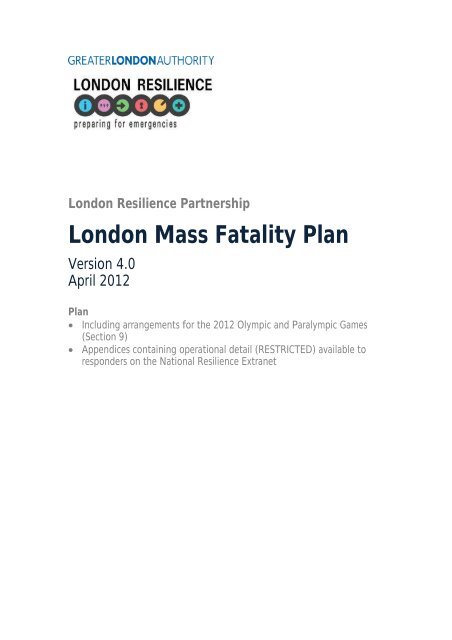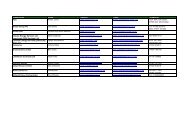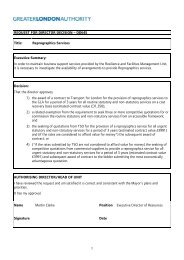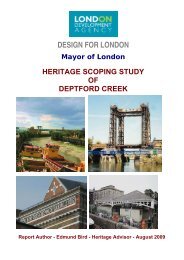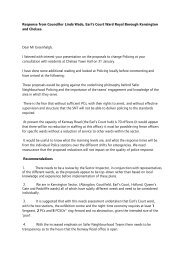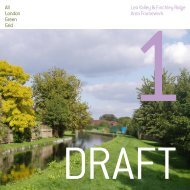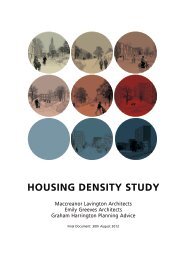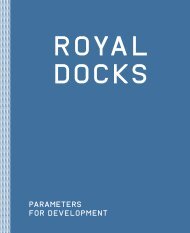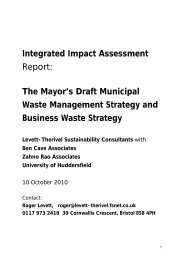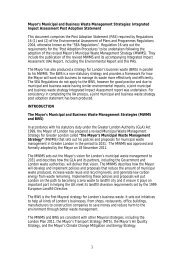London mass fatality plan version 4 - Greater London Authority
London mass fatality plan version 4 - Greater London Authority
London mass fatality plan version 4 - Greater London Authority
Create successful ePaper yourself
Turn your PDF publications into a flip-book with our unique Google optimized e-Paper software.
<strong>London</strong> Resilience Partnership<br />
<strong>London</strong> Mass Fatality Plan<br />
Version 4.0<br />
April 2012<br />
Plan<br />
Including arrangements for the 2012 Olympic and Paralympic Games<br />
(Section 9)<br />
Appendices containing operational detail (RESTRICTED) available to<br />
responders on the National Resilience Extranet
NOT PROTECTIVELY MARKED<br />
PAGE LEFT INTENTIONALLY BLANK
TABLE OF CONTENTS<br />
TABLE OF CONTENTS .........................................................................................3<br />
RECORD OF AMENDMENTS ..............................................................................5<br />
LONDON MASS FATALITY PLAN INFORMATION SHEET ..........................6<br />
SECTION 1 - INTRODUCTION ............................................................................7<br />
1.1 Aims of the <strong>plan</strong> .........................................................................................7<br />
1.2 Purpose of the <strong>plan</strong> .....................................................................................8<br />
1.3 Threats and risks.........................................................................................8<br />
1.4 Considerations during a Mass Fatality incident ...........................................8<br />
1.5 Lord Justice Clarke ....................................................................................9<br />
1.6 Signposting to other <strong>plan</strong>s.........................................................................10<br />
1.7 Useful websites.........................................................................................11<br />
1.8 Security classification...............................................................................11<br />
SECTION 2 - ROLES, RESOURCES AND ASSETS ..........................................13<br />
2.1 Home Office Emergency Preparedness Fatality Team...............................13<br />
2.2 Cadre of coroners......................................................................................13<br />
2.3 Metropolitan Police Services DVI.............................................................13<br />
2.4 <strong>London</strong>’s coroner and Designated Disaster Mortuaries .............................13<br />
2.5 National Emergency Mortuary Arrangements (NEMA) ...........................13<br />
2.6 <strong>London</strong> NEMA sites .................................................................................14<br />
2.7 Temporary mortuary licence .....................................................................14<br />
2.8 Family liaison...........................................................................................14<br />
2.9 Family viewing.........................................................................................15<br />
2.10 Costs.....................................................................................................15<br />
2.11 Disaster Appeal Fund <strong>plan</strong> ....................................................................16<br />
2.12 Chemical, Biological, Radiological, Nuclear and Enhanced Conventional<br />
Weapons (CBRNE) ............................................................................................16<br />
2.13 Humanitarian Assistance Centre ...........................................................16<br />
2.14 Religious and cultural issues .................................................................16<br />
2.15 The Voluntary Sector Capabilities document.....................................16<br />
SECTION 3 - PLAN ACTIVATION.....................................................................18<br />
3.1 Mass Fatality Operational Plan .....................................................................18<br />
3.2 Police and the coroner...............................................................................18<br />
3.3 <strong>London</strong> Resilience Team ..........................................................................18<br />
3.4 Local <strong>Authority</strong> ........................................................................................18<br />
3.5 Mass Fatality Co-ordination Group...........................................................19<br />
3.6 Requesting central assistance....................................................................19<br />
3.7 Gold / Strategic Co-ordinating Group .......................................................20<br />
SECTION 4 - INTERNATIONAL DIMENSION.................................................22<br />
4.1 Foreign and Commonwealth Office ...........................................................22<br />
4.2 UK Disaster Victim Identification Team...................................................22<br />
SECTION 5 - COMMUNICATIONS AND MEDIA STRATEGY......................23<br />
5.1 <strong>London</strong> Media Emergency Protocol..........................................................23<br />
5.2 The <strong>London</strong> Resilience Team ...................................................................23<br />
<strong>London</strong> Mass Fatality Plan Page 3 of 73<br />
Version 4
NOT PROTECTIVELY MARKED<br />
SECTION 6 - HEALTH AND SAFETY ...............................................................25<br />
SECTION 7 – DEBRIEFING ................................................................................26<br />
SECTION 8 - TRAINING AND EXERCISING...................................................27<br />
SECTION 9 – OLYMPICS 2012 MASS FATALITY PLANNING .....................28<br />
9.1 Disaster Victim Identification (DVI).........................................................28<br />
SECTION 10.0 - GLOSSARY OF TERMS ..........................................................29<br />
<strong>London</strong> Mass Fatality Plan Page 4 of 30<br />
Version 4
RECORD OF AMENDMENTS<br />
Date Version Author Changes<br />
Any queries or enquiries should be directed to lrt@london.gov.uk.<br />
<strong>London</strong> Mass Fatality Plan Page 5 of 27<br />
Version 4
LONDON MASS FATALITY PLAN INFORMATION SHEET<br />
Who is the<br />
national lead?<br />
Who is the <strong>London</strong><br />
co-ordination<br />
lead?<br />
Who initiates the<br />
<strong>London</strong> Mass<br />
Fatality Plan?<br />
Who notifies the<br />
<strong>London</strong> Mass<br />
Fatality Incident?<br />
What<br />
communication<br />
methods will be<br />
used?<br />
When will the<br />
<strong>London</strong> Mass<br />
Fatality Plan be<br />
reviewed?<br />
Key Partner<br />
responsibilities<br />
Who will<br />
coordinate the<br />
media response?<br />
Delivery of pan<br />
<strong>London</strong> measures<br />
Home Office<br />
Head of <strong>London</strong> Resilience<br />
The decision whether to convene a partnership meeting or monitor the<br />
situation will be made during a Tripartite discussion between Her Majesty’s<br />
Coroner, Metropolitan Police Service and LRT<br />
Partners will be notified according to the LESLP Protocol and a Gold<br />
Coordinating Group formed.<br />
A <strong>London</strong> media cell will sit alongside the Gold Coordinating Group,<br />
through which public messages will be formed and communicated. A public<br />
spokesperson will be nominated.<br />
Bi annually revision unless an incident or lessons from exercises requires<br />
earlier revision<br />
Her Majesty’s Coroner – takes strategic control of incident and sets scope<br />
and nature of post mortem response<br />
Metropolitan Police Service – initiates Disaster Victim Identification process<br />
and Investigation in consultation with Coroner<br />
<strong>London</strong> Resilience Team – Co-ordinates Local <strong>Authority</strong> Response and acts<br />
as conduit from regional to central government tiers<br />
Coordinated through the media cell.<br />
The Gold coordination group will coordinate and deal with pan <strong>London</strong><br />
multi agency issues.<br />
<strong>London</strong> Mass Fatality Plan Page 6 of 30<br />
Version 4
SECTION 1 - INTRODUCTION<br />
The <strong>London</strong> Mass Fatality Plan (LMFP) provides a comprehensive basis for <strong>plan</strong>ning and<br />
delivering a response to a <strong>mass</strong> <strong>fatality</strong> incident in the Capital, as informed by the<br />
National Risk Register and the National Planning Assumptions 2008 (Restricted).<br />
Following any incident resulting in <strong>mass</strong> <strong>fatality</strong>, there will be a range of physical,<br />
evidential, safety and psychological challenges to those organising and directing the<br />
response. The recovery of fatalities is taxing for those directly involved and is generally<br />
an emotive issue. The process must be carefully handled, balancing the need to preserve<br />
the integrity of any crime scene and resulting evidence with the safety of staff<br />
undertaking the process whilst maintaining, so far as possible, the dignity of the<br />
deceased and having regard to the to the social and ethnic sensibilities of their relatives.<br />
In incidents involving chemical, biological, radiological or nuclear materials, these<br />
challenges are further complicated by the possible presence of contaminating agents on<br />
and around the fatalities which present potential health risks 1 .<br />
The LMFP is intended for use by representatives of all agencies who would have a role<br />
in the management of a <strong>mass</strong> <strong>fatality</strong> incident in the Capital. The operational detail is<br />
presented in the Appendices (Restricted).<br />
A <strong>mass</strong> <strong>fatality</strong> incident is defined as ‘any incident where the number of fatalities is<br />
greater than normal local mortuary arrangements can manage’. Any <strong>plan</strong> for dealing<br />
with fatalities needs to be integrated with all aspects of the response and recovery.<br />
Organisations need to work in collaboration with others on key activities and ensure<br />
their own <strong>plan</strong>s are robust.<br />
This <strong>plan</strong> is produced and maintained by the <strong>London</strong> Resilience Team and sits alongside<br />
the Strategic Emergency Plan for <strong>London</strong> and other relevant emergency <strong>plan</strong>s to meet<br />
the requirements of the Civil Contingencies Act 2004 and the obligations it places on<br />
responders in the event of an emergency. Version 4 of the LMFP replaces all previous<br />
<strong>version</strong>s and will be reviewed as and when necessary, but within two years of<br />
publication.<br />
1.1 AIMS OF THE PLAN<br />
To provide an integrated emergency response to a <strong>mass</strong> <strong>fatality</strong> incident in the<br />
capital.<br />
To provide options for dealing with incidents involving large numbers of human<br />
fatalities. The <strong>plan</strong> may also be used in response to an incident overseas which<br />
calls for the identification and repatriation of large numbers of UK Nationals.<br />
To act as a signposting document to other agencies and more detailed <strong>plan</strong>s.<br />
1<br />
The Safe Handling of Contaminated Fatalities Guidance Document June 2009 Home Office<br />
<strong>London</strong> Mass Fatality Plan Page 7 of 30<br />
Version 4
1.2 PURPOSE OF THE PLAN<br />
To ensure that <strong>London</strong> has a capability to respond rapidly, effectively and flexibly with<br />
the consequences of an incident involving Mass Fatality:<br />
Support for those who have been bereaved, including communication of<br />
information about fatalities to those who have been bereaved and to the wider<br />
public<br />
Ensuring that information about current local mortuary capacity and other<br />
resources is readily available to the Mass Fatality Coordination and Gold<br />
Coordinating Groups<br />
Establish and audit the availability of sufficient specialist staff locally or<br />
regionally, including Disaster Victim Identification (DVI) staff, Forensic Matching<br />
Specialists, Forensic Odontologists, Forensic Pathologists and Anatomical<br />
Pathology Technologists (APTs)<br />
Planning for any National Emergency Mortuary Arrangements (NEMA)<br />
deployment (connection of utilities, ground quality, disposal of waste, transport,<br />
security of site, etc)<br />
Ensuring readiness to respond to other Mass Fatality emergencies during or<br />
soon after the initial emergency.<br />
1.3 THREATS AND RISKS<br />
Mass <strong>fatality</strong> incidents can occur without warning and can broadly be expected to fall<br />
within:<br />
Natural events - flooding, severe weather, earthquakes, etc<br />
Major accidents - including transport, industrial, and fire<br />
Malicious attacks - including terrorism and criminality<br />
Crowd related incidents - involving disorder and/or overcrowding.<br />
1.4 CONSIDERATIONS DURING A MASS FATALITY INCIDENT<br />
Lessons learned from other <strong>mass</strong> <strong>fatality</strong> incidents and exercises indicate that the<br />
following issues may arise and <strong>plan</strong>ners need to be aware of:<br />
Planners should assume potential for wide dispersal of victims and body parts<br />
For each incident, a Casualty Bureau (police led) may be established to collate<br />
and pass on to police relevant data about persons who have been reported as<br />
missing<br />
The bodies of victims may require storage for significant periods of time in order<br />
to assist with evidence for criminal investigations and in order to allow time for<br />
the Coroner to confirm the identities of those who are deceased<br />
<strong>London</strong> Mass Fatality Plan Page 8 of 30<br />
Version 4
In some cases it may not be possible to identify victims at all<br />
Normal infrastructures such as communications, utilities and transportation may<br />
suffer severe, possibly unmanageable disruption<br />
Severe pressures may affect established procedures including those for<br />
identification, post mortems and burials<br />
Media and political interest is likely to be intense<br />
There are likely to be exceptional demands for public information<br />
Human aspect requirements relating to victims, the bereaved, survivors,<br />
witnesses and responders will be significant<br />
There may be multi-national, multi-cultural and multi-religious aspects<br />
There is potential for confusion over the numbers of missing persons/potential<br />
victims including misrepresentation and hoaxes<br />
Public confidence may suffer in respect of the nature of the incident and/or the<br />
effectiveness of the response.<br />
There may be long term implications linked to:<br />
Ongoing identification and investigation requirements, inquiries and<br />
proceedings<br />
Rebuilding, environmental clean up and regeneration<br />
Legal issues<br />
Economic impact<br />
Human aspects and social impact<br />
Tributes, memorials and appeals<br />
Anniversaries and key dates.<br />
1.5 LORD JUSTICE CLARKE<br />
It is worthwhile considering four key principles which Lord Justice Clarke 2 believed<br />
should be kept in mind throughout the identification process following a major<br />
emergency:<br />
The provision of honest and as far as possible accurate information at all times,<br />
at every stage<br />
Respect for the deceased and the bereaved<br />
A sympathetic and caring approach throughout<br />
2 Lord Justice Clarke, 2001<br />
<strong>London</strong> Mass Fatality Plan Page 9 of 30<br />
Version 4
The avoidance of mistaken identity.<br />
1.6 SIGNPOSTING TO OTHER PLANS<br />
In contrast with emergencies such as a pandemic, (refer to The <strong>London</strong> Regional Flu<br />
Pandemic Response Plan) where the cause of death would in most cases be known,<br />
emergencies resulting in Mass Fatality require careful investigation to establish the<br />
circumstances of death and the identification of the deceased. This <strong>plan</strong> does not<br />
consider generic responses; such as the management of an incident or crime scene,<br />
Disaster Victim Identification (DVI) procedures or the details of the work of pathologist<br />
or other specialist staff investigating the cause of death, guidance on which is available<br />
elsewhere.<br />
It is important that this <strong>plan</strong> is read in conjunction with existing emergency procedures<br />
and <strong>plan</strong>s. For guidance, these have been signposted below:<br />
<strong>London</strong> Resilience Strategic Emergency Plan Version 6 (available from<br />
http://www.london.gov.uk/priorities/london-prepared/preparinglondon/<strong>plan</strong>ning-emergencies-london).<br />
This document contains links to the<br />
following <strong>plan</strong>s:<br />
- <strong>London</strong> Emergency Services Liaison Panel (LESLP) Major Incident<br />
Procedure Manual which includes information on Rest Centres and<br />
Survivor Reception and Family & Friends Reception Centres<br />
- <strong>London</strong> Command and Control Protocol<br />
- The <strong>London</strong> Science and Technical Advice Cell Arrangements (STAC)<br />
- <strong>London</strong> Recovery Management Protocol<br />
- <strong>London</strong> Humanitarian Assistance Centre Plan<br />
- The <strong>London</strong> Chemical, Biological & Radiological Response Framework<br />
- <strong>London</strong> Structural Collapse Response and Recovery Framework<br />
- <strong>London</strong> Resilience Strategy for Disability Equality in Emergency Planning<br />
- The Voluntary Sector Capabilities Document<br />
- Disaster Appeal Fund Plan<br />
- <strong>London</strong> Local <strong>Authority</strong> Gold Operating Procedures<br />
- The <strong>London</strong> Media Emergency Plan<br />
National Emergency Mortuary Arrangements (NEMA) - ‘Supplementing Local<br />
Response Options’ - Home Office, 2010 [Restricted] – Available National<br />
Resilience Extranet<br />
Mass Fatality Operational Plan Appendix A (Restricted)<br />
NEMA and DDM Activation Plans Appendix xx (Restricted)<br />
MPS Specialist Crime Directorate (DVI) Guidance to the roles and responsibilities<br />
of police officers/staff within a mortuary following a major incident resulting in<br />
<strong>fatality</strong> (Restricted)<br />
ACPO DVI manual is a generic concept of operations for Police Forces and<br />
identifies roles and responsibilities - currently under review<br />
Association of Chief Police Officers (ACPO) Emergency Procedures Manual -<br />
ACPO 2009<br />
<strong>London</strong> Mass Fatality Plan Page 10 of 30<br />
Version 4
Dorries, C. (1998) Coroners Courts; A guide to law and practice. Chichester.<br />
Wiley<br />
‘Guidance on Dealing with Fatality in Emergencies’ - Home Office / Cabinet<br />
Office, 2004 - is primarily aimed at local responders. It reaffirms and<br />
consolidates what local services should consider when <strong>plan</strong>ning how to respond<br />
in the event of an emergency. Advice is offered on all aspects of a <strong>mass</strong> <strong>fatality</strong><br />
response.<br />
http://webarchive.nationalarchives.gov.uk/+/http://www.cabinetoffice.gov.uk<br />
/media/132748/fatalities.pdf<br />
Mass Fatality Recovery Guidance - Cabinet Office<br />
http://www.cabinetoffice.gov.uk/content/national-recovery-guidancehumanitarian-aspects-<strong>mass</strong>-fatalities<br />
Cabinet Office Emergency Response and Recovery Non statutory guidance to<br />
complement emergency preparedness<br />
http://www.cabinetoffice.gov.uk/sites/default/files/resources/emergencyresponse-recovery_0.pdf<br />
The Needs of Faith Communities in Major Emergencies: Some Guidelines -<br />
Home Office, 2005<br />
http://webarchive.nationalarchives.gov.uk/+/http://www.cabinetoffice.gov.uk<br />
/media/132745/faith_communities.pdf<br />
Home Office - Responding to a terrorist incident:<br />
www.homeoffice.gov.uk/counter-terrorism/responding-to-an-incident/<br />
National Police Improvement Agency (NPIA) Family Liaison Officer (FLO)<br />
Guidance<br />
http://www.npia.police.uk/en/docs/Family_Liaison_Officer_Guidance_2008.p<br />
df<br />
The Safe Handling of Contaminated Fatalities - Home Office Guidance<br />
document June 2009 – (Restricted).<br />
1.7 USEFUL WEBSITES<br />
<strong>London</strong> Resilience http://www.londonprepared.gov.uk/<br />
UK Resilience http://www.cabinetoffice.gov.uk/ukresilience<br />
Home Office http://www.homeoffice.gov.uk/<br />
Directgov<br />
http://www.direct.gov.uk/en/Governmentcitizensandrights/Dealingwithemergencies/<br />
Preparingforemergencies/index.htm<br />
1.8 SECURITY CLASSIFICATION<br />
The main part of this <strong>plan</strong> is unrestricted and may be shared with relevant interested<br />
parties. Some appendices, however, are marked as ‘Restricted’ and should, therefore,<br />
<strong>London</strong> Mass Fatality Plan Page 11 of 30<br />
Version 4
not be released to agencies outside of the <strong>London</strong> Resilience Partnership without prior<br />
authority of the <strong>London</strong> Resilience Team.<br />
<strong>London</strong> Mass Fatality Plan Page 12 of 30<br />
Version 4
SECTION 2 - ROLES, RESOURCES AND ASSETS<br />
Many of the roles that will be crucial in the response to Mass Fatality incidents are<br />
explained in the guidance: Dealing with Disaster and the Home Office publication:<br />
Guidance on Dealing with Fatality in Emergencies – 2004 (see 1.11 above - signposting<br />
to other <strong>plan</strong>s)<br />
2.1 HOME OFFICE EMERGENCY PREPAREDNESS FATALITY TEAM<br />
The Home Office Emergency Preparedness Fatality Team provides national guidance<br />
and co-ordinates National Mass Fatality Planning; it also manages the Central<br />
Assistance Programme (CAP).<br />
2.2 CADRE OF CORONERS<br />
A UK DVI Cadre of Advisory Coroners has been established to advise the Home Office<br />
and to provide support to other coroners as they <strong>plan</strong> and if an incident occurs.<br />
2.3 METROPOLITAN POLICE SERVICES DVI<br />
The Metropolitan Police Service (MPS) has a number of DVI officers that can be<br />
deployed in response to a <strong>mass</strong> <strong>fatality</strong> incident.<br />
2.4 LONDON’S CORONER AND DESIGNATED DISASTER MORTUARIES<br />
<strong>London</strong> has eight coronial areas covering the 33 <strong>London</strong> Boroughs including the City of<br />
<strong>London</strong>, each with an appointed Coroner. Each Coroner has nominated a mortuary<br />
within their coronial area to act as a designated disaster mortuary, in the event of a<br />
<strong>mass</strong> <strong>fatality</strong> incident, with the exception of the City of <strong>London</strong>. The City of <strong>London</strong> has<br />
arrangements in place to use one of the other seven designated disaster mortuaries.<br />
Details of designated disaster mortuaries are outlined in the Mass Fatality Operational<br />
Plan refer Appendix A (Restricted).<br />
HM Coroner is responsible for the investigation into the cause and circumstances of<br />
violent or unnatural deaths, or sudden deaths of an unknown cause, until such time as<br />
they are released for burial or cremation. The Family Liaison Officer as part of their role<br />
will explain to family members the role of the Coroner, the process of identification and<br />
keep family members updated regards the identification and/or investigation.<br />
2.5 NATIONAL EMERGENCY MORTUARY ARRANGEMENTS (NEMA)<br />
It is recognised that despite thorough <strong>plan</strong>ning and preparation for reasonably<br />
foreseeable emergencies, local mortuary capacity may sometimes be exceeded. Under<br />
these circumstances, the National Emergency Mortuary Arrangements (NEMA) supplied<br />
<strong>London</strong> Mass Fatality Plan Page 13 of 27<br />
Version 4
through Kellogg, Brown and Root (KBR) may be deployed through the Home Office<br />
Central Assistance Programme. NEMA cannot be deployed in a CBRNE environment.<br />
The Central Assistance Programme Outlined in ‘Supplementing Local response Options<br />
2010 (Restricted) comprises:<br />
A temporary demountable structure (NEMA) capable of configuration to one<br />
structure to receive 600 complete fatalities or two structures capable of receiving<br />
300 complete fatalities<br />
General mortuary equipment, which can be used with the NEMA or to equip a<br />
designated disaster mortuary<br />
x radiographic mortuary equipment, which can be used with the NEMA or to equip a<br />
designated disaster mortuary<br />
x 96 capacity temporary storage areas which can be used to enhance either NEMA<br />
or the designated disaster mortuary<br />
There is no numerical threshold for the deployment of NEMA as the circumstances of<br />
the incident, availability of local capacity, the degree of fragmentation of bodies and<br />
the Coroner’s instructions will be factors in determining deployment. Planning for<br />
tactical and operational aspects of the deployment of NEMA will require the<br />
participation of all agencies involved in the Mass Fatality response.<br />
2.6 LONDON NEMA SITES<br />
<strong>London</strong> Resilience Team in consultation with the Metropolitan, City of <strong>London</strong> and<br />
British Transport Police, Local Authorities and <strong>London</strong> Coroner’s has identified a<br />
number of suitable sites across <strong>London</strong> that can accommodate the NEMA (refer to<br />
Appendix (Restricted).<br />
2.7 TEMPORARY MORTUARY LICENCE<br />
Temporary mortuary facilities will require a licence from the Human Tissue <strong>Authority</strong>.<br />
LRT has consulted with the Human Tissue <strong>Authority</strong> (HTA) and KBR and has completed,<br />
in part, an application for a temporary mortuary licence for use with the NEMA. This<br />
approach is viewed as best practice and has been recommended to be adopted<br />
regionally.<br />
HTA guidance and activation contacts are contained within the Operational Plan<br />
Appendix A (Restricted).<br />
2.8 FAMILY LIAISON<br />
Where there is a police investigation into the death of a human being, the police have a<br />
positive duty to communicate effectively and inclusively with the bereaved family.<br />
Following a Mass Fatality incident this will be achieved by deploying a Family Liaison<br />
Officer (FLO).The primary role of the FLO is that of an investigator and will involve<br />
facilitating the forensic retrieval of Ante Mortem data from the deceased’s home and/or<br />
<strong>London</strong> Mass Fatality Plan Page 14 of 30<br />
Version 4
families by Ante-Mortem Forensic Teams. DNA material, finger and palm marks, dental<br />
records and other identifiers such as photographs would be routinely collected to assist<br />
the Senior Identification Manager (SIM) in identifying those involved.<br />
A comprehensive and rigorous strategy should accompany every FLO deployment and<br />
should be supervised by a trained Family Liaison Co-ordinator (FLC). The aims of the<br />
strategy must be clearly defined with realistic and achievable objectives based on the<br />
evidential requirements of the case. This will assist in better management of the<br />
deployment and a more structured exit process.<br />
2.9 FAMILY VIEWING<br />
It is the absolute right for bereaved families to view the remains of their loved ones,<br />
subject to health and safety issues that may be prevailing, such as CBRN contamination.<br />
Viewings are rarely conducted on the basis of visual identification due to improved<br />
technology in scientific identification disciplines such as DNA.<br />
In many cases, families will want to view their loved one for human and emotional<br />
reasons and should not be discouraged from doing so, although clear and direct<br />
information should be provided by the FLO to the family regarding the physical<br />
condition of the loved one in order to allow the family to make informed decisions<br />
regarding the viewing process.<br />
Where possible steps will be made to repatriate the body to a nominated funeral<br />
director where viewings can be conducted with the maximum dignity and respect for the<br />
families concerned. Funeral homes are designed for this purpose and this rationale is<br />
designed to divert the family away from the mortuary where intrusive clinical procedures<br />
are being conducted that may compound the family’s distress.<br />
2.10 COSTS<br />
It is recommended that the Local <strong>Authority</strong> and the Police provide financial<br />
representatives to attend the Mass Fatality Co-ordination Group meeting. Finance<br />
representatives must be authorised to make decisions, at an early stage of the response.<br />
Ongoing costs should be documented and monitored throughout.<br />
The Coroners Act 1988 covers finance arrangements, expenses and costs incurred by the<br />
Coroner. The Coroner is funded by the Local <strong>Authority</strong>.<br />
Local Authorities may be able to recover some costs incurred in responding to the<br />
incident through the Government grant aid scheme such as the “Bellwin” rules<br />
(operated under Section 155 of the Local Government and Housing Act 1989), details<br />
of grant rates and thresholds are on the website:<br />
http://www.communities.gov.uk/localgovernment/localgovernmentfinance/bellwinsch<br />
eme/<br />
<strong>London</strong> Mass Fatality Plan Page 15 of 30<br />
Version 4
2.11 DISASTER APPEAL FUND PLAN<br />
The Disaster Appeal Fund Plan was developed by the <strong>Greater</strong> <strong>London</strong> <strong>Authority</strong> for a<br />
catastrophic event occurring in the <strong>Greater</strong> <strong>London</strong> area and is endorsed and supported<br />
by the <strong>London</strong> Regional Resilience Forum. The <strong>plan</strong> is based on the experience in<br />
setting up an appeal fund following bombings in <strong>London</strong> on 7th July 2005. The <strong>plan</strong><br />
can be accessed through the Strategic Emergency Plan.<br />
2.12 CHEMICAL, BIOLOGICAL, RADIOLOGICAL, NUCLEAR AND ENHANCED<br />
CONVENTIONAL WEAPONS (CBRNE)<br />
The Home Office has produced a guidance document on the safe handling of<br />
contaminated fatalities in the event of a CBRN attack (Restricted).<br />
The guidance has been designed primarily to be used by those who may be required to<br />
deal with contaminated fatalities at the scene of a terrorist incident involving CBRN<br />
materials. It does not deal with incidents involving hazardous industrial substances<br />
(HAZMAT incidents).<br />
<strong>London</strong> Resilience has produced a <strong>London</strong> Chemical, Biological Radiological (CBR)<br />
response framework (Restricted). This outlines the framework within which the <strong>London</strong><br />
Resilience partner agencies would counter a CBR emergency.<br />
2.13 HUMANITARIAN ASSISTANCE CENTRE<br />
The <strong>London</strong> Humanitarian Assistance Centre Plan provides guidance for the delivery of<br />
a <strong>London</strong> Humanitarian Assistance Centre in the event of an “emergency”.<br />
This <strong>plan</strong> should be read in conjunction with the LESLP manual which outlines the use<br />
and operation of additional assistance centres - Rest Centres, Survivor Reception<br />
Centre, and Family and Friends Reception Centres.<br />
The Humanitarian Assistance Plan and LESLP manual can be accessed through the<br />
<strong>London</strong> Strategic Emergency Plan.<br />
2.14 RELIGIOUS AND CULTURAL ISSUES<br />
The religious cultural and ethical considerations of the main religious faiths and ethnic<br />
groups in the UK are included in the Home Office document The Needs of Faith<br />
Communities in Major Emergencies: Some Guidelines (2005).<br />
2.15 THE VOLUNTARY SECTOR CAPABILITIES DOCUMENT<br />
The Voluntary Sector Capabilities Document has been designed to promote and raise<br />
awareness of the potential voluntary sector contribution within the <strong>London</strong> region, and<br />
can be used as a reference tool to assist Category One and Two responders, as defined<br />
by the Civil Contingencies Act, 2004, when engaging with the Voluntary Sector. It sets<br />
<strong>London</strong> Mass Fatality Plan Page 16 of 30<br />
Version 4
out the Protocol designed to set out the services and resources available from the<br />
voluntary sector in the response to an incident.<br />
<strong>London</strong> Mass Fatality Plan Page 17 of 30<br />
Version 4
SECTION 3 - PLAN ACTIVATION<br />
The LMFP, may be invoked when a Mass Fatality incident occurs in <strong>London</strong> where the<br />
number of fatalities is greater than normal local mortuary arrangements can manage.<br />
The <strong>plan</strong>, or any component part, may also be activated in response to an incident<br />
overseas which calls for the identification and repatriation of large numbers of UK<br />
nationals.<br />
The establishment of the Mass Fatality Coordination Group will trigger the <strong>London</strong> Mass<br />
Fatality Plan.<br />
3.1 MASS FATALITY OPERATIONAL PLAN<br />
A Mass Fatality operational <strong>plan</strong> has been produced to act as an aide memoire to those<br />
responsible for delivering the operational response, in the first instance, to a <strong>mass</strong><br />
<strong>fatality</strong> incident. Refer to Appendix A (Restricted).<br />
3.2 POLICE AND THE CORONER<br />
Following a report of a Mass Fatality Incident, the Police and/or The <strong>London</strong> Resilience<br />
Duty Officer will inform the Coroner and Coroner’s Officer. A number of different units<br />
within the Metropolitan Police Service (MPS) will be notified dependant upon the type<br />
of incident including:<br />
Specialist Crime Directorate (SCD) - responsible for Disaster Victim Identification<br />
(DVI), body recovery, forensics, evidence gathering, investigation and the<br />
mortuary<br />
Central Operations (CO3)<br />
Counter Terrorism Command.<br />
3.3 LONDON RESILIENCE TEAM<br />
A Mass Fatality incident may come to the attention of LRT in two ways:<br />
Through any of the <strong>London</strong> Resilience Partnership agencies and its subsequent<br />
declaration as a major incident, including liaison or advice received through<br />
Local <strong>Authority</strong> (LA) stakeholders<br />
Specific notification by the Metropolitan Police Service.<br />
3.4 LOCAL AUTHORITY<br />
Following a report of a <strong>mass</strong> <strong>fatality</strong> incident the Local <strong>Authority</strong> and Local <strong>Authority</strong><br />
Gold will be notified by the <strong>London</strong> Local <strong>Authority</strong> Coordination Centre.<br />
<strong>London</strong> Mass Fatality Plan Page 18 of 30<br />
Version 4
3.5 MASS FATALITY CO-ORDINATION GROUP<br />
Following a <strong>mass</strong> <strong>fatality</strong> incident the police Senior Identification Manager (SIM) and<br />
Senior Investigation Officer (SIO) in consultation with the Coroner will need to assess<br />
the potential number of fatalities and consider the complexity of the incident (i.e.<br />
condition of the victims, extent of disruption and whether multiple sites are involved).<br />
The Mass Fatality Co-ordination Group (MFCG), chaired by the Coroner, is a multi<br />
agency group (diagram 1 depicts the membership of the MFCG core membership). The<br />
Coroner, SIO, SIM and Pathologist will set the policy and strategic framework for body<br />
recovery and identification. A representative of the MFCG will report to the Gold Coordinating<br />
Group.<br />
The MFCG will select the most appropriate mortuary option to manage the incident. The<br />
options are scaleable and could include one or a combination of:<br />
Local <strong>Authority</strong> mortuaries<br />
One or all of the seven designated disaster mortuaries<br />
One or all of the seven designated disaster mortuaries with additional<br />
refrigerated body storage obtained through the open hire market at the time of<br />
the incident<br />
National Emergency Mortuary Arrangements through the Home Office Central<br />
Assistance Programme (CAP).<br />
A written record must be made of all decisions made by the Mass Fatality Co-ordination Group<br />
and minutes will be taken of all meetings.<br />
Initial membership of the MFCG could include:<br />
Coroner (Chair)<br />
Coroner’s officer<br />
Supervising Forensic Pathologist<br />
Senior Investigation Officer (SIO) (police)<br />
Senior Identification Manager (SIM) (police)<br />
Mortuary Facilities Manager (usually appointed by the Local <strong>Authority</strong>)<br />
A strategic representative from the Local or ‘Lead’ Local <strong>Authority</strong><br />
A representative of the <strong>London</strong> Resilience Team (LRT)<br />
Police Mortuary Operations Manager<br />
Senior member of the Human Tissue <strong>Authority</strong><br />
Designated Individual under HTA licence<br />
Home Office representative<br />
Licence holder<br />
Building Control Manager /Designated Contractor in the case of a structural<br />
collapse leading to Mass Fatality.<br />
3.6 REQUESTING CENTRAL ASSISTANCE<br />
The MFCG will decide if <strong>London</strong>’s mortuary capacity (all options) has been exceeded<br />
and to request deployment of NEMA or component parts of the Central Assistance<br />
<strong>London</strong> Mass Fatality Plan Page 19 of 30<br />
Version 4
Programme, thorough Gold, and indicate what elements of the capability they require.<br />
The request will then be forwarded to the Home Office Mass Fatality Team and the<br />
decision documented.<br />
3.7 GOLD / STRATEGIC CO-ORDINATING GROUP<br />
In response to a ‘major incident’ the initial Gold Co-ordinating Group will consist<br />
primarily of the ‘blue light’ emergency services. Additional Gold level representation<br />
from other agencies will be dependent upon the requirements of the incident (e.g.<br />
nature, scale and dynamics). The <strong>London</strong> Resilience Team (LRT) will be notified of all<br />
formally declared major incidents that meet the LESLP definition by the Metropolitan<br />
Police Service.<br />
For further information on the Gold / Strategic Co-ordinating Group arrangements refer<br />
to the <strong>London</strong> Resilience Command and Control Protocol.<br />
<strong>London</strong> Mass Fatality Plan Page 20 of 30<br />
Version 4
Diagram 1 - Mass Fatality Co-ordination Group - Core Membership<br />
Operation<br />
Support *<br />
Casualty<br />
Family Liaison<br />
Co-ordinator<br />
Victim<br />
Recovery Team<br />
Leader<br />
Mortuary<br />
Operations<br />
Manager<br />
Mortuary Facilities<br />
Manager<br />
(Usually appointed by<br />
Local <strong>Authority</strong>)<br />
Senior<br />
Identification<br />
Manager<br />
Human Tissue<br />
<strong>Authority</strong><br />
* Attendance may be required for update purposes. Other complementary members may attend as required.<br />
<strong>London</strong> Mass Fatality Plan Page 21 of 27<br />
Version 4<br />
HM Coroner<br />
Chair<br />
LRT<br />
Representative<br />
Administrative Support<br />
Supervising Forensic<br />
Pathologist<br />
Senior<br />
Investigating<br />
Officer<br />
Strategic Local <strong>Authority</strong><br />
Representative<br />
(Local or agreed Lead)<br />
<strong>London</strong> Resilience Team<br />
Advice / link to<br />
Government Liaison Team
SECTION 4 - INTERNATIONAL DIMENSION<br />
4.1 FOREIGN AND COMMONWEALTH OFFICE<br />
The Foreign and Commonwealth Office (FCO) are able to respond and/or assist in<br />
fatalities incidents involving either foreign nationals who have died or have been killed<br />
in the UK or British nationals who have died or been killed whilst overseas.<br />
4.2 UK DISASTER VICTIM IDENTIFICATION TEAM<br />
UK Disaster Victim Identification Team (UKDVI) is managed by the Association of Chief<br />
Police Officers (ACPO) and has capacity to deploy in the United Kingdom at the request<br />
of the Chief Police Officer responsible for the incident and abroad, at the request of the<br />
Foreign Office. Request for this facility must be made through the Police National<br />
Information Co-ordination Centre (PNICC) using the established mutual aid request<br />
format, identifying what skills are required.<br />
<strong>London</strong> Mass Fatality Plan Page 22 of 30<br />
Version 4
SECTION 5 - COMMUNICATIONS AND MEDIA STRATEGY<br />
In the event of a <strong>mass</strong> <strong>fatality</strong> incident in <strong>London</strong>, existing media and communications<br />
<strong>plan</strong>s and protocols will be used - refer to the <strong>London</strong> Resilience Command and Control<br />
Protocol and <strong>London</strong> Media Emergency Protocol.<br />
5.1 LONDON MEDIA EMERGENCY PROTOCOL<br />
As outlined in the <strong>London</strong> Media Emergency Protocol, The broad principles on which<br />
the Mayor’s media protocol rests are that the Mayor’s role is to support the operational<br />
response to an emergency in <strong>London</strong> by providing a unified statement – a “voice for<br />
<strong>London</strong>”. It will be the Mayor’s role to provide pan-<strong>London</strong> information and reassurance<br />
throughout the duration of the response and into the initial stages of the recovery<br />
phase – this role will be undertaken in close collaboration with the Strategic Coordinating<br />
Group, and where appropriate central government, normally through the lead<br />
government department.<br />
The media will not be allowed access to the mortuary, to the Humanitarian Assistance<br />
Centre or any Friends and Relatives or Survivor Reception Centres.<br />
In general, all communications must be undertaken with sensitivity. The deceased must<br />
be treated with dignity and the needs of the bereaved should be respected.<br />
The media will receive information regarding the <strong>mass</strong> <strong>fatality</strong> incident at the Media<br />
Centre. A designated local authority Press Officer and/or police Media Liaison Officer<br />
will represent the necessary departments. Facts and figures pertaining to the number of<br />
<strong>fatality</strong> etc will only be provided to the media when verified and, then, through the use<br />
of a single, pre-identified, point of contact. This contact MUST be the only means of<br />
communicating these figures.<br />
Names of the deceased will not be released until their family members have been<br />
notified and sufficient time has elapsed to enable them to notify other relatives and<br />
loved ones. The identities of the deceased MUST not be released without the authority<br />
of the SIM.<br />
5.2 THE LONDON RESILIENCE TEAM<br />
The <strong>London</strong> Resilience Team (LRT) provides a useful link between central government<br />
and local responders during an emergency, and is well positioned to take a multi-agency<br />
view of an event.<br />
The LRT will play a key communications role in a Mass Fatality incident by: cascading<br />
information from central government to the wider partnership, liaising with the<br />
Government Liaison Team, who have links to Lead Government Department, providing<br />
advice, guidance and expertise (particularly in relation to pan-<strong>London</strong> <strong>plan</strong>s) to local<br />
responders and facilitating inter-agency communications. Resource permitting, LRT will<br />
attend meetings of the Mass Fatality Coordination Group.<br />
<strong>London</strong> Mass Fatality Plan Page 23 of 30<br />
Version 4
Key stakeholders to be consulted and informed include: Category 1 and 2 responders,<br />
the voluntary sector, the faith community, local community groups/leaders and<br />
businesses.<br />
<strong>London</strong> Mass Fatality Plan Page 24 of 30<br />
Version 4
SECTION 6 - HEALTH AND SAFETY<br />
All deploying services and agencies are required to comply with the requirements of the<br />
health and Safety at Work Act 1974, and all other relevant statutory provisions and<br />
recognised codes of practice to provide, as far as is reasonably practicable, a safe<br />
working environment 3 .<br />
It is recommended that a risk based methodology is to be adopted to manage the<br />
hazards and risks faced. Each service or agency involved will be responsible for the<br />
health and safety of their own staff, for ensuring risk assessments have been completed<br />
for all tasks, and control measures (including safe systems of work) are implemented<br />
and communicated to staff before assets are deployed. Where appropriate, issues will be<br />
referred to the Strategic (Gold) Group for further directions this will include the<br />
Scientific/Technical Advice Cell (STAC) who can inform the health and safety risk<br />
assessment process and safe systems of work.<br />
There may be instances where the response requires that work is delayed until safe<br />
operating arrangements are put in place, such as the recovery of casualties and victims.<br />
It is important to ensure that all responders and other personnel are not endangered in<br />
a way which would increase the potential for further casualties and fatalities.<br />
Risk assessments for health and safety and health protection may rule out any, or some,<br />
victim recovery in certain circumstances.<br />
Any Mass Fatality incident will place enormous demands upon all those staff involved it<br />
is important to ensure that provision is in place to support all those involved in such<br />
work.<br />
3 The Safe Handling of Contaminated Fatalities Guidance Document June 2009 Home Office<br />
<strong>London</strong> Mass Fatality Plan Page 25 of 30<br />
Version 4
SECTION 7 – DEBRIEFING<br />
Debriefing is an essential function during and at the conclusion of a <strong>mass</strong> <strong>fatality</strong><br />
incident and serves a number of purposes:<br />
Focusing on the welfare of staff involved particularly where the incident has<br />
been traumatic and there is the risk of the onset of Post Traumatic Stress<br />
Disorder<br />
To immediately capture issues that may be causing ongoing and dynamic impact<br />
to a current major incident<br />
To capture and develop organisational learning to inform future operational<br />
responses to complete the debrief cycle information and comments should<br />
feedback into the appropriate meeting or command structure.<br />
<strong>London</strong> Mass Fatality Plan Page 26 of 30<br />
Version 4
SECTION 8 - TRAINING AND EXERCISING<br />
The <strong>London</strong> Resilience Team, Mass Fatality work stream, in conjunction with all its<br />
partners regularly seeks to test the LMFP at every opportunity, practicing responses to a<br />
range of incidents, including natural disasters, accidents and malicious attacks.<br />
<strong>London</strong> Mass Fatality Plan Page 27 of 30<br />
Version 4
SECTION 9 – OLYMPICS 2012 MASS FATALITY PLANNING<br />
By nature of the scale of the event, the <strong>London</strong> 2012 Olympic and Paralympic Games<br />
pose a potential challenge and risk in terms of a Mass Fatality Incident occurring. Not<br />
only will such a global event attract the interest of criminals and terrorists, but the<br />
increased volume of visitors to the capital places substantial extra burdens on transport<br />
and infrastructure.<br />
The <strong>London</strong> Resilience Team has been liaising with all appropriate agencies involved in<br />
the Olympic Planning process. Additionally a number of exercises have been run to test<br />
Olympic Resilience Capability. The issues for incidents involving contaminated or<br />
uncontaminated fatalities have been outlined in the <strong>London</strong> Olympic Resilience<br />
Planning Assumptions/ Gap Analyses.<br />
9.1 DISASTER VICTIM IDENTIFICATION (DVI)<br />
Responsibility for providing a DVI response lies with the Homicide and Serious Crime<br />
Command Specialist Crime Directorate (SCD) (1). (See Appendix - Restricted.)<br />
<strong>London</strong> Mass Fatality Plan Page 28 of 30<br />
Version 4
SECTION 10.0 - GLOSSARY OF TERMS<br />
APT Anatomical Pathological Technologist<br />
CAP Central Assistance Programme<br />
CBRNE Chemical Biological Radiological Nuclear and Explosive<br />
CCA Civil Contingencies Act<br />
CT Counter Terrorism<br />
DV Disaster Victim Identification<br />
FCO Foreign and Commonwealth Office<br />
FLO Family Liaison Officer<br />
FLC Family Liaison Co-ordinator<br />
HTA Human Tissue <strong>Authority</strong><br />
KBR Kellogg Brown and Root<br />
LACC Local <strong>Authority</strong> Command Centre<br />
LMFP <strong>London</strong> Mass Fatality Plan<br />
LRRP <strong>London</strong> Regional Resilience Partnership<br />
LRT <strong>London</strong> Resilience Team<br />
MPS Metropolitan Police Service<br />
NEMA National Emergency Mortuary Arrangements<br />
SCC Strategic Coordination Centre<br />
SCD Specialist Crime Directorate (a directorate within the Metropolitan Police<br />
that investigates crime)<br />
SCG Strategic Coordination Group<br />
SIO Senior Investigation Officer<br />
SIM Senior Identification Manager<br />
STAC Scientific Technical Advice Cell<br />
<strong>London</strong> Mass Fatality Plan Page 29 of 30<br />
Version 4
Enquiries to:<br />
<strong>London</strong> Resilience Team<br />
<strong>Greater</strong> <strong>London</strong> <strong>Authority</strong><br />
City Hall<br />
The Queen’s Walk<br />
<strong>London</strong> SE1 2AA<br />
020 7983 4000<br />
lrt@london.gov.uk<br />
www.londonprepared.gov.uk<br />
<strong>London</strong> Mass Fatality Plan Page 30 of 30<br />
Version 4


